Top brand Clearcoats at unbeatable value for money
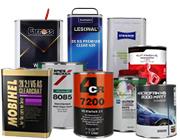
Car body Clearcoat
-
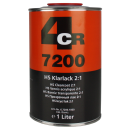 7200.1000Clearcoat 2K High Solid 2:11L
7200.1000Clearcoat 2K High Solid 2:11L -
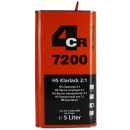 7200.5000Clearcoat 2K High Solid 2:15L
7200.5000Clearcoat 2K High Solid 2:15L -
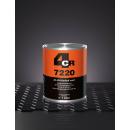 7220.10002K acrylic High Solid matt Clearcoat1L
7220.10002K acrylic High Solid matt Clearcoat1L -
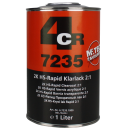 7235.10002:1 Ultra Fast Clearcoat2K HIGH SOLID 1L
7235.10002:1 Ultra Fast Clearcoat2K HIGH SOLID 1L -
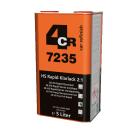 7235.50002:1 Ultra Fast Clearcoat2K HIGH SOLID 5L
7235.50002:1 Ultra Fast Clearcoat2K HIGH SOLID 5L -
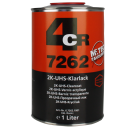 7262.10012K UHS Clearcoat2:1 Performance 1L
7262.10012K UHS Clearcoat2:1 Performance 1L -
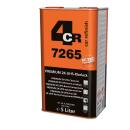 7265.50002K UHS Premium Clearcoat5L
7265.50002K UHS Premium Clearcoat5L -
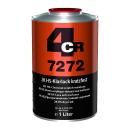 7272.10002K High Solid 2:1 anti-scratch Clearcoat1L
7272.10002K High Solid 2:1 anti-scratch Clearcoat1L -
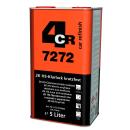 7272.50002K High Solid 2:1 anti-scratch Clearcoat5L
7272.50002K High Solid 2:1 anti-scratch Clearcoat5L -
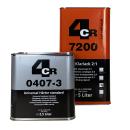 Kit 7200High Solid 2K Clearcoat Kit1 Clearcoat 5L + 1 Hardener 2.5L
Kit 7200High Solid 2K Clearcoat Kit1 Clearcoat 5L + 1 Hardener 2.5L -
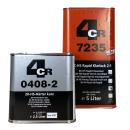 Kit 7235High Solid Ultra Fast 2K Clearcoat Kit1 Clearcoat 5L + 1 Hardener 2.5L
Kit 7235High Solid Ultra Fast 2K Clearcoat Kit1 Clearcoat 5L + 1 Hardener 2.5L -
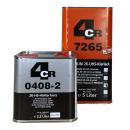 Kit 72652K UHS premium Clearcoat kit1 Clearcoat 5L + 1 Hardener 2.5L
Kit 72652K UHS premium Clearcoat kit1 Clearcoat 5L + 1 Hardener 2.5L -
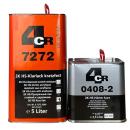 Kit 72722K High Solid anti-scratch Clearcoat kit1 Clearcoat 5L + 1 Hardener 2.5L
Kit 72722K High Solid anti-scratch Clearcoat kit1 Clearcoat 5L + 1 Hardener 2.5L -
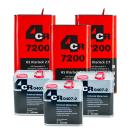 Pack 72002K High Solid Clearcoat Pack3 Clearcoats 5L + 3 Hardeners 2.5L
Pack 72002K High Solid Clearcoat Pack3 Clearcoats 5L + 3 Hardeners 2.5L -
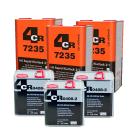 Pack 72352K High Solid Ultra Fast Clearcoat Pack3 Clearcoats 5L + 3 Hardeners 2.5L
Pack 72352K High Solid Ultra Fast Clearcoat Pack3 Clearcoats 5L + 3 Hardeners 2.5L
︾
Top brand Clearcoats available from Carross :
Applying Clearcoat to a bodywork is an essential step in ensuring long-lasting protection and an aesthetically pleasing finish to the paintwork.
Materials required:
Paint Hardener : If required according to Clearcoat specifications.
Paint Thinner: To adjust the viscosity of the Clearcoat if necessary.
Paint spray gun: Use a quality spray gun for even application.
Breathing mask, gloves and goggles : For personal safety.
Masking tape: To protect areas not intended for Clearcoat.
Surface preparation :
Ensure that the underlying Paint is dry and has cured in accordance with the manufacturer's recommendations. The surface must be clean, smooth and free of contaminants.
Protecting uncoated areas:
Use tarpaulins or Masking tape to cover parts of the vehicle not intended to be Clearcoated, such as windows, headlights and tyres.
Preparing the mixture:
Follow the manufacturer's instructions to mix the Clearcoat correctly. Some Clearcoats require the addition of a Hardener and possibly a Thinner.
Adjusting the paint gun:
Adjust the air pressure of the compressor according to the manufacturer's recommendations. Also adjust the Clearcoat flow rate and spray width on the gun.
Applying body Clearcoat:
Apply the first coat of Clearcoat using even, criss-cross strokes to ensure even coverage. Maintain a constant distance between the spray gun and the surface.
Drying time :
Allow the Clearcoat to partially dry according to the manufacturer's specifications, usually referred to as flash time, between coats. This prevents drips and improves adhesion.
Applying successive coats:
Apply several Thin layers, allowing each layer to partially dry between applications. Follow the manufacturer's recommendations on the number of coats required.
Final drying time :
Allow the Clearcoat to dry completely according to the manufacturer's specifications. Drying time may vary according to temperature and humidity.
Sanding and polishing (if necessary):
If imperfections appear, allow the Clearcoat to dry completely and sand lightly with fine abrasive paper. Then polish the surface to a smooth, shiny finish.
Finishing:
When all coats are applied and dry, examine the bodywork to ensure an even finish. Touch-ups may be necessary to correct any imperfections.
By following these steps, you should achieve a professional, long-lasting Clearcoat finish. Be sure to read the manufacturer's instructions carefully for the specific Clearcoat you are using, as products may have specific requirements.
The different types of car Clearcoat:
There are a number of different car Clearcoats, each with specific characteristics suited to different needs. Here's a list of the main car Clearcoats:
Solvent-based:
Solvent-based Clearcoats are traditional formulations that use organic solvents. They offer excellent gloss, durability and weather resistance, but can emit volatile organic compounds (VOCs)...
Acrylic
Acrylic Clearcoats are water-based and fast drying. They are transparent and glossy, but may be less resistant to chemicals and weathering than other Clearcoats.
Polyurethane :
Polyurethane Clearcoats offer excellent UV, weather and scratch resistance. They are durable and offer a sustained gloss, making them popular for automotive applications.
Fast drying :
Fast drying Clearcoats are formulated to reduce the drying time between coats and speed up the overall application process. They are often used in environments where fast drying is crucial.
High solids:
High solids Clearcoats are designed to minimise the volume of solvent remaining on the surface after drying. This reduces VOC emissions and is often sought as part of environmentally friendly practices.
Matt:
Matt Clearcoats create a shine-free effect, offering a smooth appearance. They are popular for those who prefer a more subdued, modern look.
Gloss :
Gloss Clearcoats create a smooth, highly reflective surface. They are often used to achieve a deep, rich look on high quality vehicles.
Ceramic:
Ceramic Clearcoats are innovative products that use nanotechnology to create an extremely hard, scratch-resistant protective layer. They also offer protection against the elements and make cleaning easier.
The choice of Clearcoat depends on a number of factors, including the type of paint used, climatic conditions, aesthetic preferences and durability requirements.
Your questions about using Clearcoat on a surface :
Car body Clearcoat is a crucial step in the car paint process, and it often prompts a number of questions from those undertaking the job. Here are some of the most frequently asked questions about applying Clearcoat:
What's the difference between Clearcoat and Paint?
Clearcoat is a transparent layer applied after paint to protect the surface and give it a long-lasting shine.
Why do I need to apply Clearcoat after painting my car?
Clearcoat protects the paintwork against UV rays, weathering and scratches, and provides a brilliant finish. It also improves the durability of the paintwork.
What is the difference between solvent-based Clearcoat and water-based Clearcoat?
Solvent-based Clearcoat uses organic solvents, while water-based Clearcoat is more environmentally friendly because it emits fewer volatile organic compounds (VOCs). Both offer similar results in terms of protection.
Can I use any Clearcoat with any paint?
We recommend that you use a Clearcoat that is compatible with the car paint you are using. Some paint systems are designed to be used with specific Clearcoats to ensure optimum adhesion.
Should I use a primer before applying Clearcoat?
In general, the application of a primer is recommended before painting, but the Clearcoat is applied directly onto the paint layer.
How do I prepare the surface before applying Clearcoat?
The surface must be clean, dry and free of contaminants. Light sanding may be necessary to ensure optimum Clearcoat adhesion.
What is the best method for applying Clearcoat: spray, brush or roller?
The most common and recommended method is to use a paint spray gun, as it provides an even, professional application.
How many coats of Clearcoat should I apply?
The number of coats depends on the type of Clearcoat and the manufacturer's specifications. In general, two to three Thin layers are recommended for optimum protection.
How can I avoid Clearcoat drips during application?
A regular application technique, avoiding overloading the paint spray gun, helps to minimise the risk of drips. Following the manufacturer's recommendations on dilution can also help.
How long does it take for Clearcoat to dry completely?
The drying time depends on the Clearcoat, the weather conditions and the number of coats applied.
The major brands of Clearcoat offered by Carross :
Each brand of Clearcoat has its own distinctive characteristics, aimed at offering exceptional performance in terms of application and aesthetics. Here's an overview of the main features of some of the Clearcoats from leading brands such as De Beer, Cromax, Glasurit... :
Carross :
Carross offers Clearcoats renowned for their gloss and durability. Their products offer excellent weather resistance.
De Beer :
De Beer Clearcoats are renowned for their high gloss, scratch resistance and durability. They often offer a smooth finish and exceptional adhesion.
Cromax :
Cromax, part of the Axalta Group, offers high-performance body Clearcoats. Their products are characterised by their weather resistance, durability and high gloss.
Glasurit :
Glasurit, a BASF brand, is known for its high-quality Clearcoats. Their products offer exceptional UV protection, weather resistance and a high-gloss finish.
Lechler:
Lechler stands out for its innovative Clearcoats. The brand offers a wide range of colours, customised finishes and advanced technological solutions.
Lesonal :
Lesonal, an AkzoNobel brand, offers high-quality bodywork Clearcoats. Their products are characterised by excellent adhesion and durability.
MaxMeyer :
MaxMeyer, part of the PPG group, offers reliable bodywork Clearcoat solutions. Their products are appreciated by bodybuilders for their consistent performance and adaptability to a variety of uses.
Nexa Autocolor :
Nexa Autocolor, also a member of PPG Industries, offers high-quality bodywork Clearcoats. Their products aim to provide high performance results and a wide range of tints.
PPG :
PPG, as a global coatings manufacturer, offers high-quality body Clearcoats. Their products are often characterised by their durability, resistance and weatherability.
R-M :
RM, a division of BASF, is renowned for its high-quality bodywork Clearcoats. They often offer exceptional adhesion and UV resistance.
Sikkens :
Sikkens, a brand of AkzoNobel, offers bodywork Clearcoats that stand out for their durability, exceptional gloss and weather resistance.
Spies Hecker :
Spies Hecker, part of the Axalta group, is renowned for its bodywork varnish solutions which are often appreciated for their consistent quality, ease of use and compatibility with different surfaces.
Standox :
Standox, another brand in the Axalta group, offers high-quality bodywork Clearcoats. Their products are known for their durability, ease of use and wide range of colours.